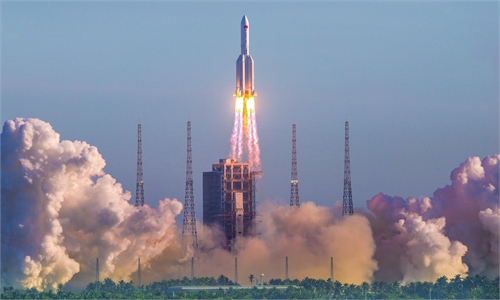Chinese people have made technological marvels through its reliance on the concept of scientific and technological innovation.
In the aerospace sector, China has been making strategic plans for practical and steady development, which are reflected in its short-term, medium-term, and long-term goals.
In the process of practicing the concept of scientific and technological innovation, CPC members have always kept in mind the aspiration of "rejuvenation of the Chinese nation," which has enabled China's space industry to achieve long-term, steady, and rapid development, and has helped in making major technological breakthroughs in key areas.
The essence of global great power competition is scientific and technological competition. China needs to lay a solid foundation for scientific and technological development. China, in especially key areas, needs to rely on its own exploration, even if the march to progress takes longer.
The country, for example, has already demonstrated its ability to launch the Long March 11 solid rocket from sea platforms. Such kinds of independent innovation capacities are also an important reflection of a country's core competitiveness.
The aerospace field is the world's most recognized high-tech field. Chinese aerospace scientists have made great efforts in key bottlenecked engineering aspects to realize the Lunar exploration mission and Mar's rover project.
It can be said that China completely relies on its own independent innovative ability to achieve an asymmetric follow-through strategy in key fields.
At present, China's overall scientific and technological innovation pathway is at a difficult stage, and we still have to achieve breakthroughs in many key areas and technologies. If it fails to achieve breakthroughs in these areas, China will be at the mercy of others, and can never become a leading science and technology power across the world.
China's scientific and technological development, including in aerospace science, has taken a tough road from importing and copying to developing and creating. Today's Chinese researchers should still possess a sense of urgency. In the research and development of semiconductor chips, for example, China must strengthen the development of a high-precision lithography machine so as not to be subjected to others' control.
China has made a series of achievements in aerospace science and technology through independent study, from the launch of satellites to the deployment of a space station, from the Lunar mission to Mars exploration, and from Beidou to the development of a complete space application system. These achievements by China will inspire other countries and regions that are interested in cooperation.
Guided by a vision of building a community with a shared future for mankind, China is willing to step up international cooperation in such fields as the space station, Beidou, and Chang'e projects.
In deep space exploration, China hopes to have more international cooperation. All these things show that China is making peaceful use of space and aerospace technology, and hopes to make contributions to the progress of mankind.
The article was written based on an interview with Song Zhongping, a Chinese military expert and TV commentator.
In the aerospace sector, China has been making strategic plans for practical and steady development, which are reflected in its short-term, medium-term, and long-term goals.
In the process of practicing the concept of scientific and technological innovation, CPC members have always kept in mind the aspiration of "rejuvenation of the Chinese nation," which has enabled China's space industry to achieve long-term, steady, and rapid development, and has helped in making major technological breakthroughs in key areas.
The essence of global great power competition is scientific and technological competition. China needs to lay a solid foundation for scientific and technological development. China, in especially key areas, needs to rely on its own exploration, even if the march to progress takes longer.
The country, for example, has already demonstrated its ability to launch the Long March 11 solid rocket from sea platforms. Such kinds of independent innovation capacities are also an important reflection of a country's core competitiveness.
The aerospace field is the world's most recognized high-tech field. Chinese aerospace scientists have made great efforts in key bottlenecked engineering aspects to realize the Lunar exploration mission and Mar's rover project.
It can be said that China completely relies on its own independent innovative ability to achieve an asymmetric follow-through strategy in key fields.
At present, China's overall scientific and technological innovation pathway is at a difficult stage, and we still have to achieve breakthroughs in many key areas and technologies. If it fails to achieve breakthroughs in these areas, China will be at the mercy of others, and can never become a leading science and technology power across the world.
China's scientific and technological development, including in aerospace science, has taken a tough road from importing and copying to developing and creating. Today's Chinese researchers should still possess a sense of urgency. In the research and development of semiconductor chips, for example, China must strengthen the development of a high-precision lithography machine so as not to be subjected to others' control.
China has made a series of achievements in aerospace science and technology through independent study, from the launch of satellites to the deployment of a space station, from the Lunar mission to Mars exploration, and from Beidou to the development of a complete space application system. These achievements by China will inspire other countries and regions that are interested in cooperation.
Guided by a vision of building a community with a shared future for mankind, China is willing to step up international cooperation in such fields as the space station, Beidou, and Chang'e projects.
In deep space exploration, China hopes to have more international cooperation. All these things show that China is making peaceful use of space and aerospace technology, and hopes to make contributions to the progress of mankind.
The article was written based on an interview with Song Zhongping, a Chinese military expert and TV commentator.

